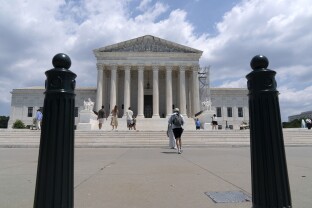The first time Donald Trump ran for president, he released a public list of potential Supreme Court nominees to signal to skeptical Republicans he’d only pick conservative judges. This year, he didn’t release a list because he didn’t have to: The GOP is well aware Trump will likely have the opportunity to nominate multiple justices to the court in his next term and stand ready to help him.
At a gathering this fall, conservative leaders met in Washington, D.C., to plan out exactly who the president-elect should consider for the bench and maintain the court’s conservative majority for generations to come.
The Center for Judicial Renewal, a part of the prominent conservative group American Family Association, released its research as to which judges and legal minds it considered “the absolute best” to replace Justices Samuel Alito, 74, and Clarence Thomas, 76, — the oldest justices — should they choose to retire in the next administration, said Phillip Jauregui, senior counsel and director of the group.
“I hope they’re there for a long time … but should one of them retire, we have to be prepared,” Jauregui told attendees of the Pray Vote Stand conference, organized by the conservative Family Research Council, in October.
Leaders in the movement already had their eyes on five potential names. Three lower court judges, Kyle Duncan (52 years old), Lawrence VanDyke (51 years old) and James Ho (51 years old), were all appointed by Trump during his first administration and on Trump’s 2020 Supreme Court short list. Former North Carolina Supreme Court Justice Mark Martin (61 years old) and Kristen Waggoner (around 52 years old), CEO of Alliance Defending Freedom, also made the Center’s list.
Most are younger than or the same age as Justice Amy Coney Barrett, the youngest member of the court, meaning they could be on the court for decades. Trump hasn’t said which names he’s actively considering — and didn’t during the campaign — betting that it might have motivated Democratic voters. Jauregui said in October that there were “good reasons why he should not, right now, and do it later.”
Trump “made it clear during the campaign he is working on a new list of Supreme Court names that will only include the best of the best,” Jauregui said in a statement to NOTUS on Friday when asked about the shortlist. A Trump spokesperson did not return a request for comment.
Now that the election is behind him, Trump will have a Republican Senate majority, ready to help him confirm whoever he wants. Sen. Chuck Grassley, who hopes to lead the Judiciary Committee and oversaw the confirmations of Neil Gorsuch and Brett Kavanaugh, congratulated Trump on Instagram and said he was looking forward to “confirming judges” under his administration.
When picking Barrett, Gorsuch and Kavanaugh, Trump relied heavily on outside legal minds from places like the Heritage Foundation and the Federalist Society and with input from evangelicals like Family Research Council’s Tony Perkins, who told Trump that Barrett was the only acceptable pick for the vacancy in 2020 following Ruth Bader Ginsburg’s death.
Leonard Leo, a conservative lawyer who has played an instrumental role in shifting the Supreme Court to the right, said in a statement, first reported by CNN, that talking about Alito and Thomas “like meat that has reached its expiration date is unwise, uninformed, and, frankly, just crass.”
But that hasn’t stopped conservatives from looking ahead.
Ed Whelan, a former clerk for the late Antonin Scalia and prominent conservative attorney who helped get Kavanaugh appointed, wrote in the National Review on Wednesday that Trump has an opportunity to “perpetuate a strong conservative majority on the Supreme Court for at least the next [20] years.”
“I expect Alito to announce his retirement in the spring of 2025,” Whelan said, adding that he also expects Thomas to “decide to retire in the spring of 2026.”
Liberals, meanwhile, have turned their attention to Justice Sonia Sotomayor, who is 70 years old and has type 1 diabetes. Democratic senators have been discussing whether to publicly call on Sotomayor to step down, Politico reported on Friday, to avoid a repeat of what happened with Ginsburg, who declined to retire during Barack Obama’s administration.
Jauregui told NOTUS that he doesn’t expect Sotomayor to retire in the next four years because she is “younger than Justices Thomas and Alito and shows absolutely no signs of slowing down.”
If Trump manages to nominate even two new justices to the bench, he would be the first president since FDR to have nominated the majority of the court, per NBC News.
A May poll from Stand Up America, an anti-Trump progressive organization, found that 74% of voters said that selection and confirmation of Supreme Court justices would be a big factor when deciding on who to vote for. Despite these numbers, Democrats failed to campaign on the issue, while Trump remained quiet.
Elliot Mincberg, senior counsel for People for the American Way and an expert on judicial appointments, told NOTUS in October that Trump might not release a Supreme Court short list to “moderate things a little bit in the context of the campaign.”
“If he does become elected, he has no reason to be moderate,” Mincberg said. “I think most people are strongly predicting that we will see a very radical far-right Donald Trump, and certainly, picking Supreme Court justices, which was one of his big successes last time, is likely to be on the list.”
—
Oriana González is a reporter at NOTUS.
Sign in
Log into your free account with your email. Don’t have one?
Check your email for a one-time code.
We sent a 4-digit code to . Enter the pin to confirm your account.
New code will be available in 1:00
Let’s try this again.
We encountered an error with the passcode sent to . Please reenter your email.


